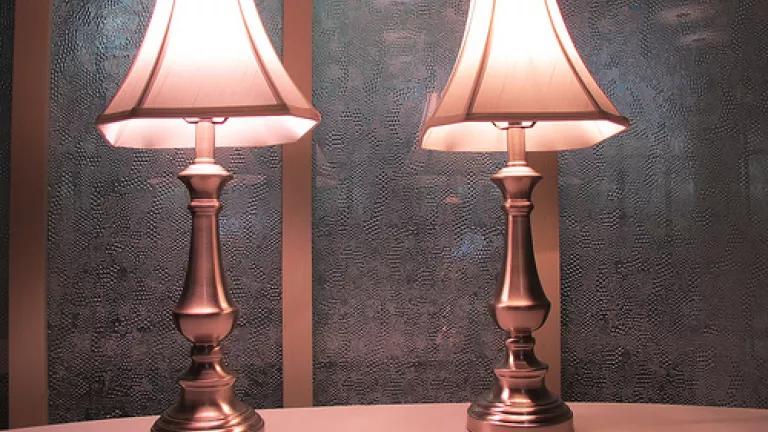
House Republicans are preparing to make war on light bulbs once again, attempting to block efficiency standards that will save consumers $100 a year on energy bills and are already creating thousands of jobs across the country. If ideologues in the House get their way, we all miss out on a chance to save money and energy, no matter what kind of light bulbs we choose to buy. And we risk hurting the domestic lighting industry, which has invested millions of dollars in developing better, more efficient bulbs.
The efficiency standard does not, as some would have you believe, get rid of traditional light bulbs--it makes them better. We can all still buy incandescent light bulbs that look just like the old ones, but use 25 to 30 percent less energy to produce the same quality of light.
New incandescent bulbs (right) give off the same light as a 100-watt bulb (left), but use less energy. (Credit: Rocky Kistner, NRDC)
You have to wonder how light bulbs have become the target of Republican extremists. After all, efficiency standards for light bulbs were signed into law by President George W. Bush in 2007, with broad bipartisan support.
These standards have actually been in effect since January 1. Even so, Republicans want to use a back-door maneuver just to get their way: They now want to prohibit funding for any enforcement of these standards, a move which would allow foreign companies to come in and sell sub-standard bulbs.
Doesn't Congress have better things to do?
The idea behind the efficiency standards is simple: Conventional light bulbs, using technology that hasn't changed much since Edison, waste about 90 percent of the electricity they use. Efficiency standards have already improved refrigerators, dryers and other big home energy users to bring down electricity costs for consumers. Light bulbs could get better, too.
The new standards required a 25 to 30 percent improvement in energy efficiency for light bulbs, which would save consumers almost $100 per year in energy expenses (about $12 billion a year nationwide). They would also offset the need for about 30 large power plants, and reduce domestic carbon pollution by 100 million tons per year -- the equivalent of taking 17 million cars off the road each year.
The advent of the standards, just as we've seen in the past, spurred a flurry of innovation in the industry, resulting in new and improved products, new jobs, and cost savings for consumers. U.S. lighting manufacturers, large and small, got to work making conventional incandescent bulbs more efficient, as well as developing new lighting technologies, including better-performing CFLs and long-lasting LED light bulbs. They supported the standards and invested millions of dollars to develop and manufacture energy-efficient lighting. Better bulbs (including incandescents) are already on the market, and the process has created thousands of jobs for engineers, factory workers, and lighting installers around the country.
According to report by the Brookings Institution, there were more than 14,000 jobs in the energy-efficient lighting sector in 2010. Ohio has become a hub for this boom. GE created about 100 new jobs in Bucyrus, Ohio, at a plant where it's manufacturing energy-efficient fluorescents. Seven hundred people work at GE Lighting’s East Cleveland campus, where the company conducts research and development for LED bulbs and other energy efficient lighting. Members of the United Steelworkers and IUE-CWA (the Industrial Division of the Communications Workers of America) are building and assembling energy-efficient incandescent light bulbs for Osram Sylvania at the company’s St. Marys and Wellsboro plants in Pennsylvania. Cree, another LED manufacturer, based in North Carolina, plans to hire more than 800 people in the next few years to meet growing demand for energy-efficient lighting.
Thousands of lighting contractors across the country are seeing their businesses grow as a result of the light bulb standards and state energy efficiency policies—some contractors in Ohio have seen their businesses double in the past few years, as more homeowners and businesses look to install energy-efficient lighting.
So why mount an offensive now against a law that George W. Bush signed in 2007? It was a good idea then, for Republicans and Democrats alike, and it's still a good idea now. Light bulb efficiency standards are money-savers and job-makers. By reducing the need for power plants and cutting global warming pollution, the standards protect our health, too. Even light bulb manufacturers support efficiency standards, now that they've invested in creating better products.
If Tea Party extremists prevent the standards from being enforced, it would open the door for foreign companies to undercut U.S. manufacturers with inferior, wasteful bulbs. "We feel it puts jobs at risk," Joseph Higbee of the National Electrical Manufacturers Association, which represents 95 percent of the lighting industry, told Bloomberg BNA last week.
People who argue that this is really about freedom to choose are absolutely right—because the new standards are in fact increasing choice. Today, consumers can walk into their local hardware store, or Sears, or Home Depot, and have the opportunity to choose a better light bulb--whether they're CFLs, LEDs, or traditional, but more efficient, incandescent bulbs. The standards are creating more choice in lighting than we've seen for the past century.
Having the House of Representatives expend energy to ensure that light bulbs waste energy is government meddling at its worst. Surely Congress has more illuminating matters to attend to.